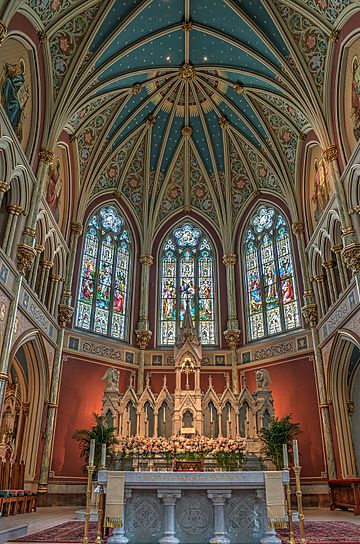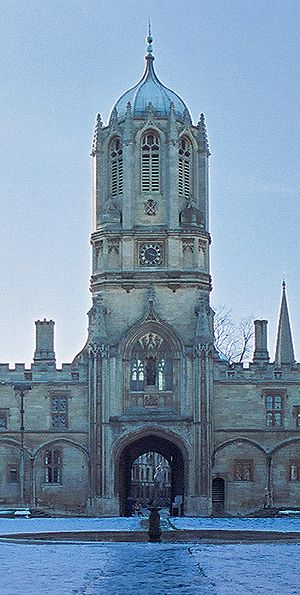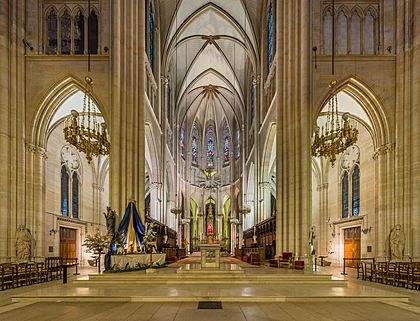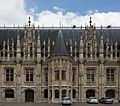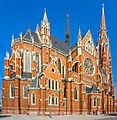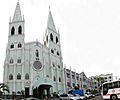Gothic Revival architecture facts for kids
Gothic Revival architecture is architecture that has been made to look as if it is from medieval times, but is really much later. This architectural style began in the late 1740s in England. Its momentum grew in the early 19th century. Serious and learned admirers of neo-Gothic styles sought to revive medieval Gothic architecture.
The Gothic style of architecture was built in Europe between about 1140 and about 1550. Beginning in late 18th century Europe, through the 19th century and into the early 20th century in Europe and elsewhere there was a fashion to build in the Gothic style. In this period architects and their patrons had various different styles to choose from. There were also revivals of Classical and Renaissance styles. Since medieval Gothic buildings vary so much, some architects often copied selectively from medieval buildings and some adapted the style to the needs of their own period. The "Gothic Revival" style was most commonly used for churches, cathedrals, universities, town halls and sometimes houses.
Gothic Revival buildings have features that are like real Gothic buildings. They often have:
- Pointed arches round the doors and windows
- Arched stoned roofs called "vaults"
- Towers and sometimes also spires on top of towers
- Many stone-carvings around the doors and fireplaces
- Stained glass windows
Contents
Roots
The rise of evangelicalism in the eighteenth and early nineteenth centuries saw in England a reaction in the high church movement which sought to emphasise the continuity between the established church and the pre-Reformation Catholic church. Architecture, in the form of the Gothic Revival, became one of the main weapons in the high church's armoury. The Gothic Revival was also paralleled and supported by "medievalism", which had its roots in antiquarian concerns with survivals and curiosities. As "industrialisation" progressed, a reaction against machine production and the appearance of factories also grew. Proponents of the picturesque such as Thomas Carlyle and Augustus Pugin took a critical view of industrial society and portrayed pre-industrial medieval society as a golden age. To Pugin, Gothic architecture was infused with the Christian values that had been supplanted by classicism and were being destroyed by industrialisation.
Gothic Revival also took on political connotations; with the "rational" and "radical" Neoclassical style being seen as associated with republicanism and liberalism (as evidenced by its use in the United States and to a lesser extent in Republican France), the more spiritual and traditional Gothic Revival became associated with monarchism and conservatism, which was reflected by the choice of styles for the rebuilt government centres of the British parliament's Palace of Westminster in London, the Canadian Parliament Buildings in Ottawa and the Hungarian Parliament Building in Budapest.
In English literature, the architectural Gothic Revival and classical Romanticism gave rise to the Gothic novel genre, beginning with The Castle of Otranto (1764) by Horace Walpole, and inspired a 19th-century genre of medieval poetry that stems from the pseudo-bardic poetry of "Ossian". Poems such as "Idylls of the King" by Alfred, Lord Tennyson recast specifically modern themes in medieval settings of Arthurian romance. In German literature, the Gothic Revival also had a grounding in literary fashions.
Survival and revival
Gothic architecture began at the Basilica of Saint Denis near Paris, and the Cathedral of Sens in 1140 and ended with a last flourish in the early 16th century with buildings like Henry VII's Chapel at Westminster. However, Gothic architecture did not die out completely in the 16th century but instead lingered in on-going cathedral-building projects; at Oxford and Cambridge Universities, and in the construction of churches in increasingly isolated rural districts of England, France, Germany, the Polish–Lithuanian Commonwealth and in Spain.
Britain and Ireland
St Columb's Cathedral, in Derry, may be considered 'Gothic Survival', as it was completed in 1633 in a Perpendicular Gothic style. Similarly, Gothic architecture survived in some urban settings during the later 17th century, as shown in Oxford and Cambridge, where some additions and repairs to Gothic buildings were considered to be more in keeping with the style of the original structures than contemporary Baroque.
In contrast, Dromore Cathedral, built in 1660/1661, immediately after the end of the Protectorate, revived Early English forms, demonstrating the restitution of the monarchy and claiming Ireland for the English crown. At the same time, the Great Hall of Lambeth Palace, that had been despoiled by the Puritans, was rebuilt in a mixture of Baroque and older Gothic forms, demonstrating the restitution of the Anglican Church. These two buildings can be said to herald the onset of Gothic Revival architecture, several decades before it became mainstream. Sir Christopher Wren's Tom Tower for Christ Church, University of Oxford, consciously set out to imitate Cardinal Wolsey's architectural style. Writing to Dean Fell in 1681, he noted; "I resolved it ought to be Gothic to agree with the Founder's work", adding that to do otherwise would lead to "an unhandsome medley". Pevsner suggests that he succeeded "to the extent that innocent visitors never notice the difference". It was followed in 1697–1704 by the rebuilding of Collegiate Church of St Mary in Warwick as a stone-vaulted hall church, whereas the burnt church had been a basilica with timbered roofs. Also in Warwickshire, in 1729/30, the nave and aisles of the church of St Nicholas at Alcester were rebuilt by Edward and Thomas Woodward, the exterior in Gothic forms but with a Neoclassical interior. At the same time, 1722–1746, Nicholas Hawksmoor added the west towers to Westminster Abbey, which made him a pioneer of Gothic Revival completions of medieval buildings, which since the late 19th century were increasingly disapproved, although work in this style continued into the 20th century. Back in Oxford, the redecoration of the dining hall at University College between 1766 and 1768 has been described as "the first major example of the Gothic Revival style in Oxford".
Continental Europe

Throughout France in the 16th and 17th centuries, churches such as St-Eustache (1532–1640, façade 1754) in Paris and Orléans Cathedral (1601–1829) continued to be built following Gothic principles (structure of the buildings, application of tracery) with some little changes like the use of round arches instead of pointed arches and the application of some Classical details, until the arrival of Baroque architecture.
In Bologna, in 1646, the Baroque architect Carlo Rainaldi constructed Gothic vaults (completed 1658) for the Basilica of San Petronio in Bologna, which had been under construction since 1390; there, the Gothic context of the structure overrode considerations of the current architectural mode. Similarly, in St. Salvator's Cathedral of Bruges, the timbered medieval vaults of nave and choir were replaced by "Gothic" stone vaults in 1635 resp. 1738/39. Guarino Guarini, a 17th-century Theatine monk active primarily in Turin, recognized the "Gothic order" as one of the primary systems of architecture and made use of it in his practice.
Even in Central Europe of the late 17th and 18th centuries, where Baroque dominated, some architects used elements of the Gothic style. The most important example is Jan Santini Aichel, whose Pilgrimage Church of Saint John of Nepomuk in Žďár nad Sázavou, Czech Republic, represents a peculiar and creative synthesis of Baroque and Gothic. An example of another and less striking use of the Gothic style in the time is the Basilica of Our Lady of Hungary in Márianosztra, Hungary, whose choir (adjacent to a Baroque nave) was long considered authentically Gothic, because the 18th-century architect used medieval shapes to emphasize the continuity of the monastic community with its 14th-century founders.
Romantic challenges
During the mid-18th century rise of Romanticism, an increased interest and awareness of the Middle Ages among influential connoisseurs created a more appreciative approach to selected medieval arts, beginning with church architecture, the tomb monuments of royal and noble personages, stained glass, and late Gothic illuminated manuscripts. Other Gothic arts, such as tapestries and metalwork, continued to be disregarded as barbaric and crude, however sentimental and nationalist associations with historical figures were as strong in this early revival as purely aesthetic concerns.
German Romanticists (including philosopher and writer Goethe and architect Karl Friedrich Schinkel), began to appreciate the picturesque character of ruins—"picturesque" becoming a new aesthetic quality—and those mellowing effects of time that the Japanese call wabi-sabi and that Horace Walpole independently admired, mildly tongue-in-cheek, as "the true rust of the Barons' wars". The "Gothick" details of Walpole's Twickenham villa, Strawberry Hill House begun in 1749, appealed to the rococo tastes of the time, and were fairly quickly followed by James Talbot at Lacock Abbey, Wiltshire. By the 1770s, thoroughly neoclassical architects such as Robert Adam and James Wyatt were prepared to provide Gothic details in drawing-rooms, libraries and chapels and, for William Beckford at Fonthill in Wiltshire, a complete romantic vision of a Gothic abbey.
Some of the earliest architectural examples of the revived are found in Scotland. Inveraray Castle, constructed from 1746 for the Duke of Argyll, with design input from William Adam, displays the incorporation of turrets. The architectural historian John Gifford writes that the castellations were the "symbolic assertion of the still quasi-feudal power [the duke] exercised over the inhabitants within his heritable jurisdictions". Most buildings were still largely in the established Palladian style, but some houses incorporated external features of the Scots baronial style. Robert Adam's houses in this style include Mellerstain and Wedderburn in Berwickshire and Seton Castle in East Lothian, but it is most clearly seen at Culzean Castle, Ayrshire, remodelled by Adam from 1777. The eccentric landscape designer Batty Langley even attempted to "improve" Gothic forms by giving them classical proportions.
A younger generation, taking Gothic architecture more seriously, provided the readership for John Britton's series Architectural Antiquities of Great Britain, which began appearing in 1807. In 1817, Thomas Rickman wrote an Attempt... to name and define the sequence of Gothic styles in English ecclesiastical architecture, "a text-book for the architectural student". Its long antique title is descriptive: Attempt to discriminate the styles of English architecture from the Conquest to the Reformation; preceded by a sketch of the Grecian and Roman orders, with notices of nearly five hundred English buildings. The categories he used were Norman, Early English, Decorated, and Perpendicular. It went through numerous editions, was still being republished by 1881, and has been reissued in the 21st century.
The most common use for Gothic Revival architecture was in the building of churches. Major examples of Gothic cathedrals in the U.S. include the cathedrals of St. John the Divine and St. Patrick in New York City and the Washington National Cathedral on Mount St. Alban in northwest Washington, D.C. One of the biggest churches in Gothic Revival style in Canada is the Basilica of Our Lady Immaculate in Ontario.
Gothic Revival architecture remained one of the most popular and long-lived of the many revival styles of architecture. Although it began to lose force and popularity after the third quarter of the 19th century in commercial, residential and industrial fields, some buildings such as churches, schools, colleges and universities were still constructed in the Gothic style, often known as "Collegiate Gothic", which remained popular in England, Canada and in the United States until well into the early to mid-20th century. Only when new materials, like steel and glass along with concern for function in everyday working life and saving space in the cities, meaning the need to build up instead of out, began to take hold did the Gothic Revival start to disappear from popular building requests.
Famous Gothic Revival examples
- Strawberry Hill at Twickenham, near London, was one of the first houses designed in the Gothic Revival style.
- The Houses of Parliament, London
- Sydney University
- São Paulo Cathedral, Brazil
- The campus of Yale University and the University of Chicago
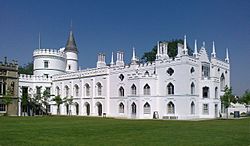
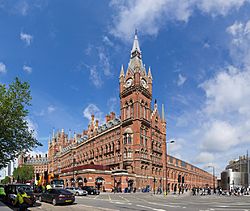
Images for kids
-
The study at Abbotsford, created for Sir Walter Scott whose novels popularised the Medieval period from which the Gothic Revival drew its inspiration
-
Cologne Cathedral, finally completed in 1880 although construction began in 1248
-
The Canadian Parliament Buildings from the Ottawa River, built between 1859 and 1876
-
The Palace of Westminster (1840–1876), designed by Charles Barry & Augustus Pugin
-
Venetian Gothic in Baku, Azerbaijan.
-
Exeter College, Oxford Chapel
-
Carcassonne – Viollet-le-Duc restored the citadel from 1853.
-
Cast-iron Gothic tracery supports a bridge by Calvert Vaux, in Central Park, New York City
-
Chhatrapati Shivaji Terminus in Mumbai, India
-
Construction of Washington National Cathedral began in 1907 and was completed in 1990.
-
Liverpool Cathedral, whose construction ran from 1903 to 1978
-
Schwerin Castle, Schwerin, Germany (1845–1857)
-
Schadau Castle, Thun, Switzerland (1846–1854)
-
Wrocław Główny railway station, Wrocław, Poland (1855–1857)
-
New Town Hall, Munich, Germany (1867–1905)
-
Town Hall, Manchester, England (1868–1877)
-
City Hall, Vienna, Austria (1872–1883)
-
Sturdza Palace, Iași County, Romania (1880-1904)
-
Hungarian Parliament Building, Budapest, Hungary (1885–1904)
-
Tower Bridge, London, England (1886–1894)
-
The Neo-Manueline (Portuguese Late Gothic) Rossio Station, Lisbon, Portugal (1891)
-
Co-cathedral, Osijek, Croatia (1898)
-
Cathedral of the Immaculate Conception, Moscow, Russia (1901–1911), an example of Brick Gothic revival
-
Basilica of Our Lady Immaculate, Guelph, Ontario, Canada
-
Rockefeller College, Princeton, USA
-
St. Patrick's Cathedral, New York, USA
-
Centre Block of the Canadian Parliament Buildings, Ottawa, Ontario
-
Basilica of Our Lady of Luján, Buenos Aires Province, Argentina
-
The São Paulo Metropolitan Cathedral, São Paulo, Brazil
-
Basilica del Salvador, in Santiago, Chile
-
The Las Lajas Sanctuary in southern Colombia
-
Basílica del Voto Nacional, Quito, Ecuador
-
St Paul's Cathedral, Melbourne, Australia
-
St Patrick's Cathedral, Melbourne, Australia
-
Christchurch Cathedral, Christchurch, New Zealand
-
Otago Boys High School, Otago, New Zealand
-
Church of the Saviour, Baku, Azerbaijan
-
Basilica of the Sacred Heart of Jesus, Pondicherry, India
-
Basílica Menor de San Sebastián, Manila, Philippines
-
Sacred Heart Cathedral, Guangzhou, China
See also
 In Spanish: Arquitectura neogótica para niños
In Spanish: Arquitectura neogótica para niños


